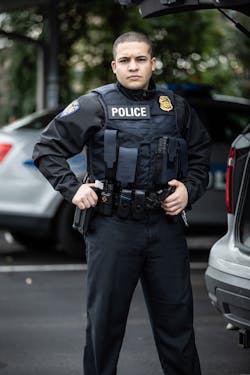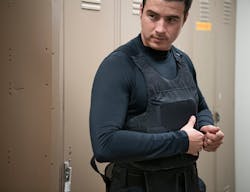Law enforcement officers have a tough enough job. They should not be fighting with their uniforms while on the job as well. Our officers should have the most comfortable, best-fitting uniforms available.
There are some interesting new trends in LEO uniforms on the market today. Here you will find a review of some of the hottest new trends in material, design and function.Body armor shirt carriers
One of the best advances in uniform technology is integrating body armor into the uniform. For years, officers wore their body armor under their uniform top. This meant one more item of equipment to maintain, clean, etc. The trend began a decade ago to address officer comfort demands. A better way of describing it would be integrating the uniform into the body armor. Brands like 5.11 Tactical, Elbeco and Flying Cross have come up with body armor covers that give the appearance of uniform tops with buttons and pockets. This cover surrounds the body armor and is worn as an outer garment, over a base uniform top. The evolution of body armor shirt carriers today aids in efficiently equipping officers with specialized equipment. Radio mic clips, body camera loops, wired earpiece buttonholes and hidden storage pockets all enhance safety and performance.Duty belt vs duty vest
Another trend recently is law enforcement departments moving weight from duty belts and wearing duty vests. Duty vests are a hybrid between body armor shirt carriers and a tactical vest. They are a crossover product that looks professional with the functionality of a tactical vest. There are several reasons why vests make more sense for officers. The obvious one is that it is more comfortable to wear while sitting in a patrol car. But it also makes more sense physiologically. Wearing a duty belt places a strain on the hips and lower back and can cause problems for officers after just a few years on the job. A typical fully accessorized duty belt weighs 25 pounds. Duty vests distribute the weight better across the body, resulting in less strain on muscles and better overall comfort for the officer. Most duty vests incorporate MOLLE webbing or fixed utility pockets providing abundant room for equipment. Gear is easier to access on the front of a vest than some spots on a duty belt, like the middle of the back for instance. Officers with muscular arms and shoulders often cannot reach the middle of their back, a prime location to keep handcuffs on their duty belt. Subsequently, duty vests increase safety and allow officers to wear ample equipment comfortably while performing multiple job functions.Fabric technology
Fabric technology has become a pioneer industry for both uniforms and fashion. Through advanced technologies and innovative designs, law enforcement uniforms solve job-specific challenges while also enhancing performance, protection, comfort and durability.
Many uniform fabric technologies are borrowed from military research and development. The concept behind ripstop fabric was first proposed during World War II. Those overseeing the U.S. Army’s combat uniforms needed fabric that would be resistant to tears and rips on the battlefield. Today, most law enforcement uniform manufactures produce Class A and Class B styled products for current policing.
Choosing a uniform fabric requires analyzing job functions and understanding local geographic weather variables. Trending uniform fabric technologies include moisture wicking, UV protection, anti-microbial and pathogen resistant fabrics. Modern uniforms utilizing these technologies ensure a crisp, professional look with built-in features that keep you dry, repel stains and hold up in the wash, all while feeling lightweight and comfortable.
Moisture-wicking fabric does two things. When you sweat, it draws the moisture away from your body to the outer layer of fabric. This helps your body regulate your internal temperature. The moisture-wicking fabric also dries quickly, so that it does not feel wet against your skin. Cotton and wool fabrics absorb moisture, and take on a heavy, damp feel. Because moisture-wicking clothes are made of synthetic “hydrophobic” material, they prevent moisture from building up. The moisture moves through the fabric to the outer air where it evaporates.
Athletic apparel has long been moisture-wicking. Sports uniforms and workout clothes that people frequently sweat in have adopted the technology and now most of these products are made with moisture-wicking fabrics. But recently, active professions like military, police, EMS and firefighters have started wearing moisture-wicking base layers. This allows them to sweat on the job but remain feeling fresh and dry all day long.
EMTs, paramedics and other emergency medical responders frequently find themselves exposed to blood and bodily fluids. If they encounter these substances, either directly or because they seep through clothing, these professionals face great risk of contracting bacteria and diseases. Pathogen-resistant apparel will prevent these harmful microbes from reaching your skin.
Agencies located within the Sun Belt should consider garments with UV Protection. Excessive exposure to sunlight is harmful to LEO and their uniforms. Garments with UV40+ protection offers your skin a frontline defense against the sun while also preventing the fabric from fading. Sun fading reduces garment lifecycle, which increases overall uniform costs.
Human skin and human sweat can produce several microbes and bacteria that create unpleasant odors. Today, textile constructions, fabric treatments or both are used to block these organisms from being active. Some odor protecting uniforms are made using yarns that contain copper, silver and other metals that are naturally anti-microbial. Synthetic fabrics are more prone to odor, so if a uniform is made of polyester or nylon, look for products with harmless chemical treatment to block odor formation. Anti-microbial technology reduces the accumulation of bacteria that cause odor to keep the fabric fresher longer and prolong the life of your uniform. If you are wearing cotton, wool or rayon uniforms, you are in luck: human skin is acid-based, so these naturally acid fibers repel odor on their own.Functional stretch
Different brands call it by different names, but one of the newest technologies in uniforms is the functional stretch technology. The concept is a material that stretches in every direction and returns to its original form. This means a much more comfortable feel for the wearer, as well as increased range of motion over traditional materials such as cotton.
Today’s technology allows for a combining of the technologies mentioned above into a single material. It is possible to create a fabric that is both durable like Ripstop as well as moisture-wicking to prevent that sticky feeling. This material also stretches to allow maximum range of motion. Flying Cross has a line of uniforms called STAT, which stands for Stretch, Tenacious, Athletic, Technical. These uniforms incorporate all the latest technology into one of the most advanced law enforcement uniform materials available today.
Soft look vs military look
These days, law enforcement has been in the spotlight, and much of it has not been positive. With police interactions with citizens under more intense scrutiny lately, and a push to “demilitarize” the police, uniforms have also undergone some changes. In the past we have seen police uniforms mirror the military “Battle Dress Uniform” style with cargo pockets, shoulder patches to identify units and rank insignia on the arms. While some of those remain, the uniforms themselves have undergone a “softening” to look more casual and less military. Exterior cargo pockets have been replaced with in seam zipper pockets providing a more finished look. Button down shirts with scalloped pocket flaps and military creases are now available with softer looking mitered pocket flaps and no military creases. Many agencies have replaced the traditional police shirt with performance polos. All these actions are being taken by many jurisdictions to make police look more approachable.
Conclusion
There have been many changes in first responder uniform technology in recent years. Changes to make uniforms more durable and yet more comfortable for the officer have improved the day-to-day lives of officers around the globe. As new fabric technology advances, you can bet that uniform technology will advance with it.
About the Author
Steve Zalkin is president of the North American Association of Uniform Manufacturers and Distributors. Contact him at [email protected] with questions about your uniform program and personal equipment needs.







